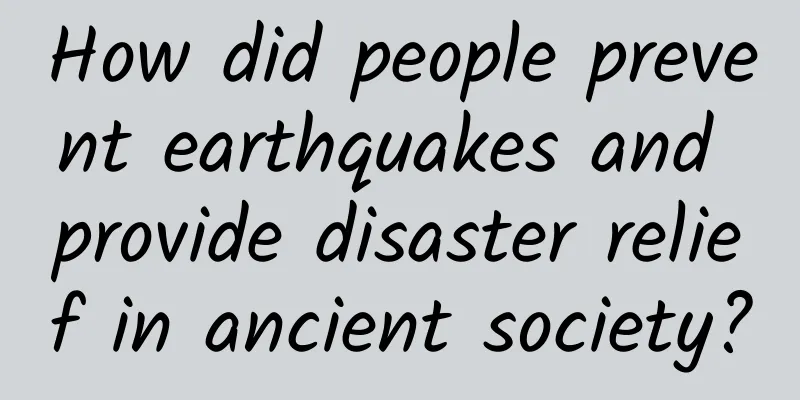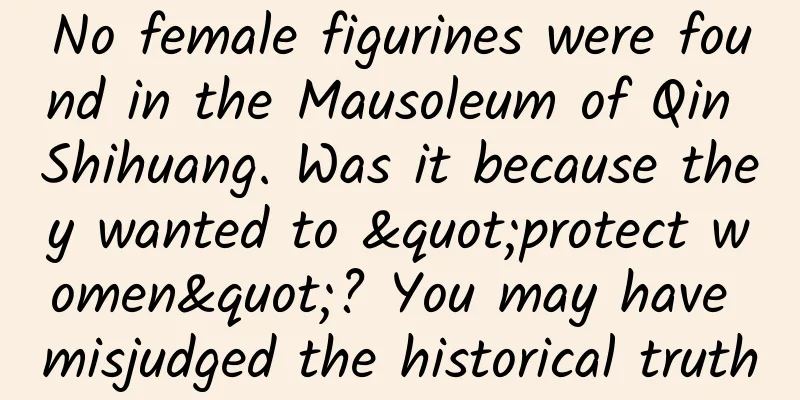How did people prevent earthquakes and provide disaster relief in ancient society?

|
A brief discussion on the strategies of ancient people in dealing with earthquakes Zhang Jiasheng The earthquake recorded in the Bamboo Annals in the third year of Emperor Yi of the Shang Dynasty, more than 3,000 years ago: In the hundredth year of Emperor Huangdi Xuanyuan's reign, the ground in Youxiong (now Linxia) cracked. Emperor Zhi ascended. Xia Emperor Fa, also known as Hou Jing or Fa Hui, ascended the mountain in the seventh year. Xia Emperor Gui, whose name was Jie. In the tenth year, the five planets moved in a disorderly manner, and at night, stars fell like rain. (Zhenqi: Pizhou in present-day Xuzhou) An earthquake occurred. Yi and Luo rivers dried up. In the third year of the reign of Emperor Yi of the Shang Dynasty, whose name was Xian, the king ordered Nan Zhong to march westward to resist the Kunyi and build a city in Shuofang. In the sixth month of summer, an earthquake occurred in Zhou (Xiqi). Since ancient people had no way of understanding the truth of natural science, they often believed that disasters were punishment from heaven for the bad behavior of the rulers, and were also the so-called "heavenly punishment". Therefore, whenever natural disasters occurred, the emperors had great ideological pressure and issued edicts to blame themselves, conduct self-examination and criticism, in order to deal with the punishment from heaven. Shang Tang, the founding monarch of the Shang Dynasty, once prayed to heaven not to implicate the people because of a severe drought, and all the people's guilt was borne by himself. According to statistics from scholars, a total of 79 emperors in Chinese history have issued edicts to blame themselves. In addition to investigating the responsibility for causing natural disasters, the ruling class of each dynasty has taken specific and effective measures to provide relief to the victims. In the Zhou Dynasty, there were records of the emperor ordering the distribution of food, money, and clothing to provide relief to the poor. The "Spring and Autumn Annals of Yan Zi" also recorded that Yan Zi asked Qi Jinggong to provide grain relief to the victims. In the Western Han Dynasty, the state banned mountains, forests, rivers and lakes, and people were not allowed to cut down trees or hunt in normal times. At this time, the victims were allowed to go in and hunt to survive the disaster year. Emperor Xuan of Han, Liu Xun: "Disasters and anomalies are warnings from heaven and earth" Earthquake relief mechanism Today is a modern society with advanced science and technology information. After experiencing the test of natural disasters, my country has established a systematic rapid disaster relief response mechanism and a permanent earthquake relief headquarters of the State Council to respond to sudden earthquake disasters at any time. So, how did they quickly provide disaster relief in the ancient society where science and technology information was far behind? According to relevant information, although the ancient people had a very poor understanding of earthquakes, they often believed that natural disasters were caused by problems in the governance of the rulers, which led to the punishment of God. However, this idea did not make them panic and stagnate, but instead prompted them to establish a set of rapid disaster relief systems. The first step is to report the disaster when an earthquake occurs. Once a disaster occurs in a certain place, local officials should quickly report the extent and time of the disaster to their superiors. If the disaster continues to worsen, they should also update the information to their superiors. For example, when an earthquake occurs in a certain place, the local victims should first report it to the county magistrate, who will report it to the prefectural governor, who will then report it to the governor of the province, and finally the governor will report it to the Ministry of Revenue. The second step is that when officials receive the disaster report, they should immediately send a disaster survey team to the disaster area to check the disaster situation. The purpose is to find out the disaster situation, register the disaster situation, do a good job of statistics, and provide a basis for the subsequent distribution of disaster relief materials and tax reduction. The law at that time stipulated that disaster surveyors must personally go to the door to verify the disaster situation, classify the households with different degrees of disaster, and pay special attention to the households with extremely serious disasters. The third step was to adopt a variety of disaster relief measures, the most common of which was to reduce or exempt corvée and taxes. Some rulers also sent medical teams to the disaster areas, while some emperors mainly gave money and gifts. In addition to this disaster relief mechanism, ancient rulers also set up three iron laws to deal with dereliction of duty, concealment of disaster information, and misappropriation of relief supplies. If there is any bribery or solicitation during the disaster investigation stage, it will be treated as corruption and abuse of power; if any official is perfunctory, does not conduct the investigation personally, and attempts to get away with it, he will be punished with 100 strokes of the cane, and will not be re-employed after being dismissed; finally, if the official in charge of the investigation is partial and corrupt and the superior official does not discover it, the county official will be demoted. If the county official knows that his subordinates are committing fraud and does not deal with it, he will be dismissed. And so on. Superior officials who are irresponsible will be demoted or dismissed depending on the severity of the situation. Now that we know about the ancient disaster relief mechanism, let's take a look at what high-tech the ancients invented to deal with earthquakes. The seismometer is the crystallization of the wisdom of Zhang Heng, an ancient Chinese scientist; the mortise and tenon and bracket techniques are ingenious inventions in the field of civil engineering. Although they seem simple, they contain the infinite wisdom of the ancients. Physical positioning technology Nowadays, we have the support of electronics, satellites, remote sensing and other scientific and technological support. We can conduct scientific research on earthquakes, but in ancient times, there were no such advanced technologies. How could we scientifically find the location of the earthquake? Zhang Heng, a scientist in the Eastern Han Dynasty of my country, used his wisdom to invent the Houfeng seismograph. When an earthquake occurs, a copper ball will be spit out from the mouth of the dragon in the corresponding direction and fall into the mouth of the toad below. The direction of the falling ball can be used to determine the direction of the earthquake. In this way, the country can quickly and effectively carry out disaster relief operations, thereby minimizing losses. In 132 AD, the great scientist Zhang Heng invented and manufactured the world's first earthquake detector, the "Houfeng Seismograph". It looks like a round wine jar with a cross-sectional diameter of eight feet. There is a heavy pillar in the center of the wine jar, called the "Duzhu", which can tilt in eight directions. There is a dragon head in each of the eight directions outside the wine jar, and a toad with its mouth open corresponds to the dragon head. Each of the eight dragons has a copper ball in its mouth. When the Duzhu tilts to a certain direction, the dragon mouth in that direction opens, and the copper ball falls into the toad's mouth. When an earthquake occurs, only the dragon head in the direction of the epicenter opens its mouth, and the direction of the earthquake can be determined based on this. According to Fan Ye's "Book of the Later Han", an earthquake occurred in Longxi on December 13, 134 AD. At that time, there was no earthquake in the capital Luoyang, but a copper ball fell out of a dragon's mouth. Later, news of the Longxi earthquake came, which effectively confirmed the effectiveness of the seismograph in detecting the direction of earthquakes. Note: The so-called "Houfeng" in the Houfeng seismograph refers to measuring the change of wind. Earthquakes are believed to be caused by the conflict between yin and yang qi, and the change of qi will produce wind. Wherever there is an earthquake, there will be a change of qi in that direction, and there will be wind that can be measured. The Houfeng seismograph was passed down to the Sui Dynasty. Xin Dufang of the Northern Dynasty and Lin Xiaogong of the Sui Dynasty both studied it, but it was lost in the Tang Dynasty. The seismometer uses the inertia of an object to measure earthquakes. Structuralists hold two views on this. One view is that the Duzhu is a heavy and thick hanging pendulum, and the small copper ball and the pendulum form a trigger mechanism. When the earthquake wave moves horizontally, the Duzhu shifts, causing the small copper ball to fall off and hit the mechanism. Or the Duzhu drives eight arms extending in eight directions, connected to the lever. When the pendulum swings in a certain direction, the dragon's mouth will open. Another view is that the Duzhu is an inverted pendulum, with a heavy hammer installed on the base and eight sets of mechanical devices around it. Once an earthquake occurs, the heavy hammer tilts, the Duzhu loses balance, and touches the mechanical device, causing the corresponding dragon's mouth to open. Modern Chinese and Japanese scholars have tried to restore the seismometer. Japanese scholars once experimented with an upright pendulum seismometer model and concluded that if the initial earthquake was very strong, the copper ball would fall due to the initial longitudinal wave, thus determining the direction of the earthquake. However, other earthquake research scholars pointed out that the tilting direction of the upright pendulum is random, and it is slow to react to vibrations, and cannot serve as an earthquake test. The spring used at the bottom of the upright pendulum could not be a product of the technology level of the Han Dynasty. The pendulum seismometer model passed the test of Chinese seismologists using a vibration table to simulate earthquake conditions in 2000, and has been generally recognized by the Chinese academic community. Mercury seismograph in the West in the 19th century Western society is far ahead of China in terms of modern scientific and technological development, but China was ahead of Western society by more than 1,700 years in the research and invention of the seismograph. The first real seismograph in the West was invented by Italian scientist Luigi Palmieri in 1855. It has a more complex mechanical system, using a round tube filled with mercury and equipped with an electromagnetic device. When vibrations cause the mercury to shake, the electromagnetic device triggers a built-in device that records the movement of the earth's crust, roughly showing the time and intensity of the earthquake. In the thousands of years of human history, seismic isolation technology has encountered many sudden disasters. Among the many disasters, earthquakes have caused the most casualties. In the face of disasters, we cannot actively predict earthquakes, but we can actively prevent them. Casualties in earthquakes are often caused by the collapse of buildings. However, many ancient buildings in my country have successfully withstood the test of major earthquakes, such as the Forbidden City, the Big Wild Goose Pagoda in Xi'an, the Baoen Temple Square in Pingwu County, Sichuan, and the Wooden Pagoda in Ying County, Shanxi. They have experienced many earthquakes for thousands of years and are still standing proudly. In ancient my country, mortise and tenon joints were widely used to fix wooden furniture and various parts of wooden buildings. In 2009, the "Chinese Traditional Wood Structure Construction Techniques" submitted by the Architecture Research Institute of the Chinese Academy of Arts was selected as the Intangible Cultural Heritage of Humanity by the United Nations. It was mentioned that mortise and tenon joints are convenient for production, installation and disassembly without the use of other tools and without damaging the integrity of the parts. The well-designed mortise and tenon joints are both stable and can withstand a certain degree of force. They can keep the building from shaking and collapsing during earthquakes of certain intensity. The most basic mortise and tenon joint structure consists of two components, one of which has its tenon inserted into the mortise of the other, so that the two components are connected and fixed. The part of the tenon that extends into the mortise is called the tenon tongue, and the rest is called the tenon shoulder. Mortise and tenon structure Dougong, also known as dougong, douke, hengluo, puzuo, etc., is a unique structure of Chinese Han architecture. The load-bearing structure that extends from the top of the column, the lintel and the eaves purlin or the frame is called an arch. The square wooden block between the arches is called a dougong. Together, they are called dougong. Dougong, like mortise and tenon joints, is the main structure for seismic reduction and isolation. The load of the building eaves is transmitted to the column through the dougong. Therefore, when an earthquake occurs, the dougong structure can effectively reduce the destructive force. The earliest physical bracket: the four dragons and four phoenixes scheme of the Warring States Period Dougong in contemporary architecture Image source: Tuchong Creative Since ancient times, humans have been dealing with earthquakes for thousands of years. While suffering from shocks and destruction, humans have also demonstrated super strong will and amazing vitality, and have accumulated gradually mature and rich experience. Especially since the Wenchuan earthquake, the country has attached great importance to earthquake monitoring and forecasting, and my country's earthquake monitoring, forecasting, and early warning capabilities have been continuously improved. I believe that scientists will soon be able to master the laws of earth activities, so that earthquakes will cause less and less harm to humans, and people will be able to live in a beautiful and happy home. |
Recommend
BOM cost announced for the first time. Who pays for LeEco's super phone?
April 14 (Reporter Zhang Zhichang) After being aw...
Quickly monetize Xiaohongshu's sideline business and earn money, increasing monthly income by 5,000+
Today I’m going to share with you a project that ...
A new breakthrough in transparent materials! The "black technology" of supramolecular glass
Produced by: Science Popularization China Author:...
How should a company operate a popular Douyin account?
There is no need to say much about the popularity...
The price has increased 6 times in two years. Can creative mid-roll ads replace traditional advertising positions?
"The busiest time is yet to come." As t...
Advancing 10,000 meters underground! Asia's deepest well to be drilled in Tarim Basin
On the edge of the Taklimakan Desert in Shaya Cou...
The sudden appearance of a huge star and the astronomer who calmed the public opinion crisis
In December of the second year of the Jingde reig...
Qingming Festival is coming soon, come and have a taste of spring!
Mixed Knowledge Specially designed to cure confus...
A collection of marketing models that marketing planners must have
If you don’t have ten or eight marketing models a...
Spend 2 hours writing every day, Zhihu Good Things can also make a lot of money part-time, actual monthly income exceeds 30,000+
Spend 2 hours writing every day, Zhihu Good Thing...
Google won't fix vulnerability affecting 60% of Android phones
Some time ago, Google caused an uproar by disclos...
@Parents and classmates—school is about to start, please keep these health tips in mind!
Planning: Li Peiyuan and Zhang Chao Produced by: ...
Japanese companies have been involved in emissions scandals, and Japanese media revealed how to test car fuel efficiency
Recently, according to media reports, after Mitsu...
Which fruits and vegetables have been sent to space? Tips on choosing fruits and vegetables sent to space
On June 5, the Long March 2F Yao-14 carrier rocke...









